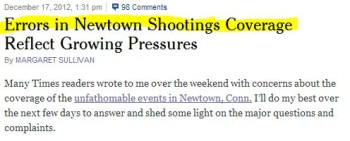
(Credit: NYT, screenshot, highlight added)
In light of reader criticism of reporting on December’s Connecticut school shootings, two public editors — NPR’s Edward Schumacher-Matos and the New York Times’ Margaret Sullivan — assessed their outlets’ reporting and emphasized the need for accuracy. As iMediaEthics has written, the urgency of media outlets to get the latest news in the tragic mass killing by gunman Adam Lanza led to numerous errors in initial reports, including misnaming Adam Lanza’s brother Ryan as the shooter, using photos from a Ryan Lanza Facebook page, and interviewing a fake Ryan Lanza.
NPR readers and listeners questioned the “detail” of NPR’s live reporting on the shootings, but Schumacher-Matos praised the outlet for its “cautious” and mostly accurate reporting. According to Schumacher-Matos, senior vice president for news Margaret Low Smith said NPR opted to devote a substantial amount of live airtime to covering the shooting because of the story’s importance and “newsworthiness.” While acknowledging he personally isn’t a fan of live reporting, Schumacher-Matos did describe NPR’s efforts to get the story right as “commendable.”
The radio network’s “newsroom has tightened its internal procedures to emphasize accuracy over speed” because of NPR’s Gabrielle Giffords mistake, Schumacher-Matos reported. As iMediaEthics wrote at the time, in its breaking news reporting on the January 2011 shooting in Arizona, NPR wrongly said U.S. Congresswoman Gabrielle Giffords was dead when, in fact, she was “seriously wounded” and has since partly recovered.
Schumacher-Matos also published a selection of staff memos on reporting about the shootings. The memos included guidance on what NPR can and “cannot report.” For example, NPR staff were advised the morning after the shooting not to report how the gunman, Adam Lanza, died, “the chronology and order of the shootings” including how Lanza got into the school, and what Lanza’s mother’s relationship to the school was.
In a later memo, NPR’s standards and practices editor Stuart Seidel addressed how NPR would handle reporting on the victims and their families including that NPR wasn’t going to name victims until “an official announcement” and that NPR wouldn’t “contact” any “family members of victims” at the time.
Seidel highlighted some exceptions and issues with its planned reporting standards, including possibly losing scoops:
“We expect that other news organizations will not respect the wishes of family members to be left alone, and we expect that some family members will contact the media or make public statements.
“On a case by case basis, we will decide whether to use quotes or information that appears in other media. (We have already made one exception: We have reported on the air and online that one of the victims is Nancy Lanza, the mother of the gunman, as law enforcement officials have told NPR.) As well, we will decide on a case-by-case basis whether to contact family members who speak publicly or release public statements.”
Meanwhile, New York Times public editor Margaret Sullivan called out the Times for some of its reporting lapses on the shooting.
“Several major” errors Sullivan noted centered on how Lanza gained access to the school. The Dec. 15 front-page article claimed “Lanza was ‘buzzed in’ to the Sandy Hook Elementary School building by its principal, who ‘recognized him as the son of a colleague.'”
However, as Sullivan explained, Lanza “forced his way into the school, dressed in combat gear and carrying guns. There is still no confirmation that his mother, Nancy Lanza, ever worked at the school.” The article carries one lengthy correction to that effect:
“An article on Saturday about the school shooting in Newtown, Conn., that left 20 children and 8 adults dead, using information from the authorities, misstated the way in which the gunman managed to enter the Sandy Hook Elementary School. The gunman, Adam Lanza, shot his way in, defeating the security system that required visitors to be buzzed in; the school’s principal did not allow him to go through the security system after recognizing him. The article also referred incorrectly to the gunman’s mother, Nancy, whom he killed in the house they shared not far from the school. She was never a teacher at the school.”
In a confusing twist, another correction on the article un-did an earlier correction about what guns Lanza used:
“A correction posted with an earlier version of this article was published in error. As the initial article correctly noted, the gunman in the Connecticut shooting used a rifle to carry out the shootings inside the Sandy Hook Elementary School; he did not use two handguns. (He did use a handgun to kill himself.)”
According to Sullivan, Times reporter and “police bureau chief” Wendy Ruderman attributed the Times‘ failures to its use of anonymous sources and incomplete verification of information. For instance, Ruderman told Sullivan “We shouldn’t put anything in the paper without a name attached to it.”
But how realistic is that suggestion? Sullivan referred iMediaEthics’ question to Times Associate Managing Editor for Standards Philip Corbett, who told us by email:
“Unfortunately, I don’t think it is realistic to think we could eliminate the use of anonymous sources in news stories. While they should be a last resort, sometimes there’s no other way to publish information that we think is important and reliable. (And, of course, sometimes named sources give wrong information, too, including official police spokesmen.)
“In a fast-changing, breaking story like Newtown, we just have to take extra care, be skeptical, and if necessary hold off longer to try to verify information.”
Sullivan called for the Times to avoid being “pulled into the maelstrom of Twitter-era news” and instead provide “authoritative and accurate counterbalance” with complete and completely accurate stories.






